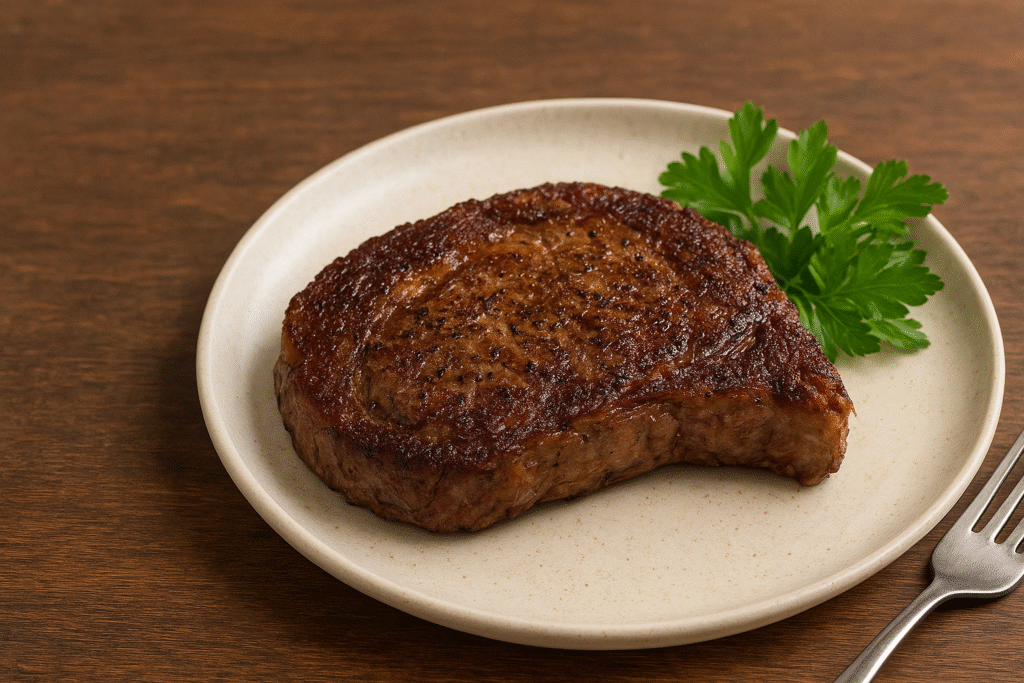1, Oct 2025
How to Cook Ribeye Steak in Oven

How to Cook Ribeye Steak in Oven for Juicy, Flavor-Packed Perfection Every Time
Sometimes, cooking steak feels like a gamble—you either nail it or end up with something closer to shoe leather. I remember thinking the same thing the first time I asked myself how to cook ribeye steak in oven without messing it up. The answer wasn’t complicated, but it did require me to rethink the way I treated heat, timing, and flavor. Like most good things in life, it’s less about perfection and more about paying attention. What surprised me most? The oven turned out to be one of the simplest, most consistent tools for steak mastery.
Choosing the right ribeye cut for oven cooking
Ribeye steak comes in different forms—bone-in, boneless, thick-cut, or thinly sliced. For oven cooking, a steak that’s at least 1 to 1.5 inches thick works best. This thickness allows the outside to caramelize beautifully without overcooking the inside. A bone-in ribeye delivers deeper flavor thanks to the marrow, while a boneless version makes slicing easier. The key is to start with high-quality meat, preferably USDA Prime or Choice grade, since the marbling of fat plays a huge role in flavor and tenderness.
When selecting ribeye, look for rich marbling throughout the meat. Those little veins of fat will melt during cooking, creating a juicy and buttery mouthfeel. A leaner cut might look pretty in the package, but it won’t deliver the same tenderness. The oven method really highlights this difference, since slow, even heat lets the fat render perfectly.
It’s also smart to buy ribeye from a trusted butcher who can guide you toward the best cut for oven cooking. Prepackaged supermarket steaks work, but if you want restaurant-level results, start with the best cut you can afford.
What tools and equipment do you need for success
Cooking ribeye in the oven doesn’t require fancy gadgets, but a few essentials make the process smoother. First, a sturdy oven-safe skillet, preferably cast iron, is your best friend. Cast iron retains heat, allowing for a perfect sear before finishing in the oven. If you don’t have cast iron, a heavy stainless steel pan works as a backup.
You’ll also need a wire rack and a baking sheet. Elevating the steak on a rack allows air to circulate around the meat, ensuring even cooking. This prevents the bottom from steaming, which can ruin the crust you worked hard to develop. A digital meat thermometer is another must-have tool. Guessing steak doneness is risky, and a thermometer takes out the uncertainty, letting you hit the exact level of doneness you prefer.
Lastly, a set of good tongs is essential for flipping and handling the steak. Forget forks—they pierce the meat and cause juices to escape. Keeping the juices inside is the difference between steakhouse quality and disappointment.
How to season ribeye steak before baking
Seasoning ribeye is all about enhancing natural flavor rather than masking it. Start with a generous sprinkle of kosher salt and freshly cracked black pepper on both sides. Let the steak sit at room temperature for about 30 minutes after seasoning. This allows the salt to penetrate the meat and helps it cook evenly once it hits the oven.
If you want to take the flavor up a notch, rub the steak with garlic powder, smoked paprika, or fresh rosemary. Some people love a drizzle of olive oil, but ribeye’s natural fat usually provides enough richness. Simplicity often works best because ribeye’s flavor speaks for itself.
For an extra boost, you can also season the steak overnight. Place it uncovered in the fridge after salting it. This dry brining method deepens flavor and helps create a better crust during searing. It’s a small step that makes a noticeable difference.
Should you sear ribeye before putting it in the oven
Searing is the secret weapon for flavor. A hot pan creates the Maillard reaction, that beautiful golden-brown crust that makes steak irresistible. While you can cook ribeye entirely in the oven, searing first locks in texture and adds depth. It’s worth the extra few minutes.
To sear, heat a skillet on high until it’s almost smoking. Add a touch of oil with a high smoke point—like canola or avocado oil. Lay the ribeye in the pan and let it sit for 2-3 minutes per side without moving it. The steak should develop a deep brown crust before transferring to the oven.
This reverse-sear method—slow baking first, then searing—also works beautifully. It produces a more consistent doneness edge to edge. Whether you sear first or last, don’t skip it. The flavor payoff is too good.
What oven temperature works best for ribeye steak
Ribeye loves a medium-high oven. The sweet spot usually falls between 375°F and 450°F depending on your method. If you sear first, 400°F works perfectly to finish the cooking without drying it out. For reverse-searing, a lower oven temp like 275°F is better to slowly bring the steak to temperature before giving it a final sear on the stove.
Cooking at very high heat alone can cause the outside to overcook while the inside remains raw. Lower heat gives you more control. Remember, ovens vary, so a thermometer remains your best guide.
For home cooks who want predictable results, sticking to 400°F after a stovetop sear is the simplest method. It balances crust formation with juicy, tender insides.
How long does it take to cook ribeye in the oven
Timing depends on thickness and desired doneness. A 1.5-inch ribeye usually takes 6–10 minutes in a 400°F oven after searing. For reverse-searing at 275°F, expect closer to 20–25 minutes before finishing in a hot pan.
Here’s a quick guide:
- Rare (125°F): 4–6 minutes
- Medium Rare (135°F): 6–8 minutes
- Medium (145°F): 8–10 minutes
- Medium Well (150°F): 10–12 minutes
- Well Done (160°F+): 12–14 minutes
These times are estimates. Always use a thermometer for accuracy, since ribeye’s marbling makes it forgiving but not foolproof. Resting the steak afterward also influences how the final temperature settles.
How to check ribeye doneness without cutting it open
The worst thing you can do is slice into a steak mid-cook to check it. That releases precious juices. Instead, rely on a digital thermometer for precision. Insert it into the thickest part of the steak, away from the bone if it’s bone-in.
If you don’t have a thermometer, use the finger test. Press the center of the steak with your finger and compare it to the feel of your hand at different positions—rare feels like the fleshy part below your thumb when relaxed, medium feels firmer like when you press your thumb and middle finger together.
While this method isn’t perfect, it works in a pinch. Still, if you cook steak regularly, investing in a thermometer pays for itself in better results every time.
What resting does for ribeye steak and why it matters
Resting might feel like an unnecessary wait, but it’s actually one of the most critical steps. When ribeye comes out of the oven, the juices are concentrated toward the center. Cutting into it right away causes those juices to spill out, leaving the meat dry.
Allowing the steak to rest for 5–10 minutes redistributes the juices evenly throughout the meat. Cover it loosely with foil to keep it warm while it rests. This simple step transforms the eating experience from good to unforgettable.
Think of resting as the steak’s chance to “finish cooking” off the heat. Skipping it can undo all the careful work you put into cooking it properly.
How to serve ribeye steak straight from the oven
Ribeye is versatile. You can slice it against the grain and serve it family-style or plate individual steaks whole. Pair it with sides that balance its richness, such as roasted vegetables, mashed potatoes, or a crisp salad. A simple compound butter—made with garlic, herbs, and a touch of lemon zest—melts beautifully over hot ribeye and elevates the flavor instantly.
Wine pairing also makes the experience more memorable. A bold red wine like Cabernet Sauvignon or Malbec complements ribeye’s fatty richness. If you prefer beer, a dark stout or hoppy IPA stands up well against the steak’s bold flavors.
Serving ribeye isn’t just about feeding people—it’s about creating an experience. The right sides and accompaniments transform a steak dinner into a moment worth remembering.
Common mistakes when cooking ribeye in the oven and how to avoid them
One of the biggest mistakes is skipping the preheat. Putting steak in a cold oven results in uneven cooking. Always preheat fully. Another mistake is overcrowding the pan or baking sheet. Too many steaks at once lower the temperature, causing steaming instead of searing.
Overcooking is another common issue. Ribeye’s marbling makes it forgiving, but it still dries out if cooked too long. That’s why using a thermometer is so important. Cutting into the steak too soon is another frequent error. Resting solves that problem.
Finally, don’t forget to season properly. Under-seasoned steak can taste flat, no matter how well cooked. Generous seasoning and high-quality cuts set you up for success before the oven even turns on.
Conclusion
Learning how to cook ribeye steak in oven is less about mastering a secret trick and more about respecting the basics—quality meat, proper seasoning, searing for flavor, precise timing, and the patience to let it rest. When you get those steps right, the result is steakhouse quality at home.
The oven gives you consistency and control, making it one of the best ways to prepare ribeye without a grill. Next time you’re craving a juicy, flavor-packed steak, skip the guesswork and follow these steps. You’ll be surprised how simple mastery can taste.
Now it’s your turn—do you prefer your ribeye rare, medium rare, or well done? Share your favorite oven steak tips in the comments, and don’t forget to pass this guide along to a fellow steak lover. After all, great food is even better when it’s shared.
Frequently Asked Questions About Cooking Ribeye Steak in the Oven
What is the best temperature to cook ribeye steak in the oven?
The best temperature for ribeye steak is 400°F after searing. For reverse-searing, use 275°F to slowly bring the steak to temperature before finishing in a hot skillet.
How long should I cook ribeye steak in the oven?
A 1.5-inch ribeye usually takes 6–10 minutes in a 400°F oven after searing. For reverse-searing at 275°F, expect about 20–25 minutes before finishing in a pan.
Do I need to sear ribeye before putting it in the oven?
Yes, searing enhances flavor by creating a golden-brown crust. You can sear before or after baking, but searing is essential for the best taste and texture.
Should I cover ribeye steak with foil in the oven?
No, ribeye should be cooked uncovered. Covering traps steam, which prevents the steak from developing a rich crust.
How do I know when ribeye steak is done?
Use a digital meat thermometer for accuracy. Rare is 125°F, medium rare is 135°F, medium is 145°F, medium well is 150°F, and well done is 160°F or above.
How long should ribeye steak rest after cooking?
Let ribeye rest for 5–10 minutes after cooking. Resting allows the juices to redistribute, making the steak juicier and more flavorful.
Can I cook ribeye steak straight in the oven without searing?
Yes, but the flavor won’t be as intense. Searing adds a deep crust and enhances the steak’s taste. If skipping sear, roast at a high temperature to mimic the effect.
What seasoning works best for ribeye steak?
Classic salt and black pepper work best. You can also add garlic powder, paprika, or fresh herbs like rosemary for extra flavor.
Is ribeye better bone-in or boneless for oven cooking?
Both work well. Bone-in ribeye offers more flavor, while boneless is easier to cook evenly and slice after baking.
What sides pair well with ribeye steak from the oven?
Great sides include roasted vegetables, mashed potatoes, garlic butter asparagus, or a crisp salad. A red wine like Cabernet Sauvignon pairs perfectly.
- 0
- By Pankajatray
- October 1, 2025 08:34 AM

